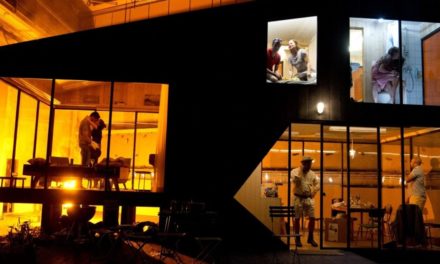After nearly half a year in quarantine, many artists still wrestle with the conundrum of COVID-era theatre: how can we create meaningful work when stripped of the in-person contact on which our field relies? Despite having made considerable strides in moving our lives and performances online, even the best Zoom play cannot fully replicate a live theatrical experience, and we find ourselves wondering whether our work’s impact can translate through screens and across distances. Produced as part of this year’s (online) Edinburgh Fringe Festival, This Is Not A Theatre Company’s Guru of Touch explores these same questions, as its titular hero and a group of Zoom attendees grapple with faith, connection, and skepticism in the name of collective healing.
Guru of Touch begins as a renowned energy healer (James Kiberd) prepares for his first digital event: forced to move his gatherings online after the pandemic, and accustomed to channeling his powers through physical touch, the Guru now fumbles with Zoom technology and personal doubts in his efforts to bridge the newfound gap between himself and his followers. Despite these misgivings, he’s determined to adapt to the new medium, and embraces the possibility that doing so might make his work even more powerful. Aided by a chipper-if-literal-minded technician (Kara Green), the Guru welcomes a motley crew of devotees and skeptics into his Zoom space for a healing session. Cara (Juliette Bennett), seeking relief from her stress migraines, fully subscribes to the notion of distance healing, maintaining that the Guru’s blessing at a prior live event helped vicariously heal her hospital-bound grandmother’s cancer. By contrast, the cynical Isabel (Mariana Cardenas) actively seeks to dismantle this theory, challenging the Guru at every turn and dismissing Cara and other attendees as audience plants. Zoey (Lipica Shah) and Ann (Lynette Freeman) vacillate between these extremes, each struggling to uphold their faith and adjust to the awkwardness of conducting such work over Zoom. Rounding out the gathering are the Guru’s ex-wife Emily (Amy Stiller), whose attempts at blank-screened anonymity fall flat, and the mysterious “Persephone’s iPad,” an incognito attendee who claims she’s only “real for six months of the year.” As the session ekes onward, testing the limits of technology and personal conviction, both Guru and participants must shelve their preconceptions in the search for deeper truth.
Within its twenty-minute run time, Guru of Touch captures the inherent strangeness of our cultural moment, and speaks to our dogged quest for authenticity within it. The touch it offers is light but resonant: send-ups of Zoom’s trademark audio-visual quirks (questionably blank screens; mute-button snafus; disruptive ambient noise) and strained efforts to replicate physical contact within tiny chat squares give way to deeper issues of faith and the power of intention in uncertain times. When our questions have no clear answers, and our actions have few tangible markers of success, how can we know if our efforts have an impact? Are we, like the Guru, merely projecting ourselves into the void and hoping for the best? Just as modern energy work has ties to prayer and various cultures’ “laying-on of hands” practices, such concerns speak to timeless existential queries about humanity’s significance and place in the universe.
While Guru of Touch takes no stance on these questions or on its own subject matter, the show’s distinctive final scene invites us to form our own conclusions. Before ending the Zoom call, the Guru directs all participants to raise their hands to the corners of their screens and share a few collective deep breaths. It’s a lovely moment in which noise and disbelief briefly suspend, giving way to simple, silent connection. And, as this sequence and the show’s technician suggest, maybe that’s the point: in healing, performance, or life itself, perhaps an endeavor “works” when enough people commit to its reality.
This post was written by the author in their personal capacity.The opinions expressed in this article are the author’s own and do not reflect the view of The Theatre Times, their staff or collaborators.
This post was written by Emily Cordes.
The views expressed here belong to the author and do not necessarily reflect our views and opinions.

















